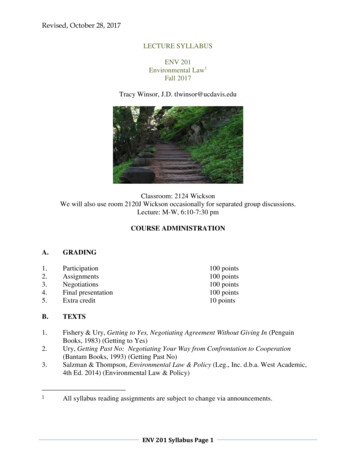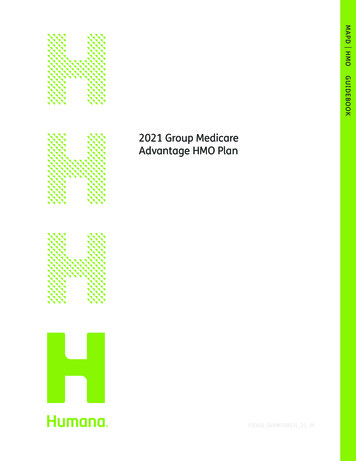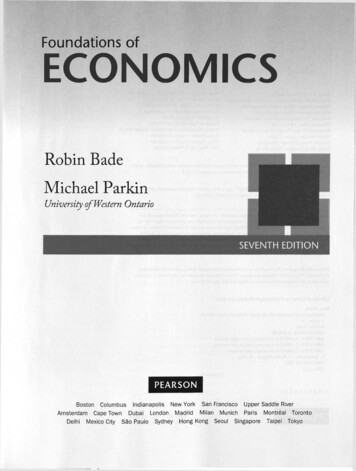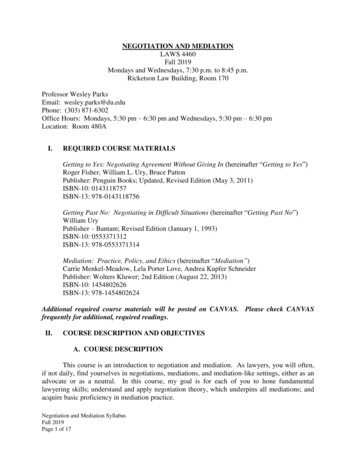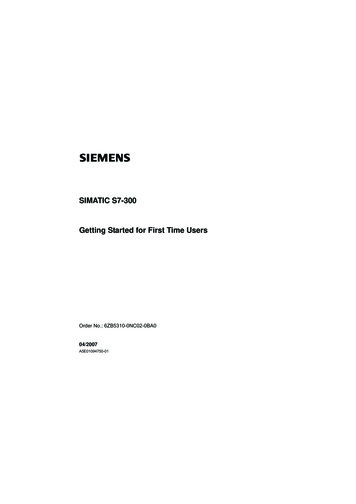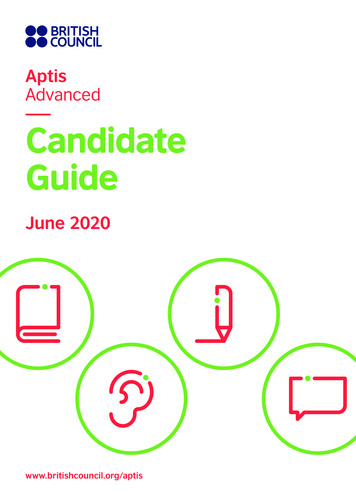
Transcription
GUIDE TO GETTING YOURPART 107DRONE LICENSE
The Part 107 Remote Pilot Certificate with an sUAS RatingTo legally fly a drone for commercial use, the pilot of the aircraft must have a remote pilot certificate with a small UAS rating. Toobtain a remote pilot certificate, a drone pilot must pass the FAA’s Airman Knowledge Exam. The Federal Aviation Administration needs to make sure that all commercial drone pilots have the ability to act responsibly, coordinate with Air Traffic Control incase of an emergency, read aeronautical maps, and abide by all regulations pertaining to UAV regulations and also generalaviation regulations.DARTdrones has trained thousands of pilots to pass their Part 107 Exam with both our in-person and online Part 107 Test PrepCourse.The remote pilot certificate is sometimesreferred to as: Drone License Remote Pilot Exam Aeronautical Knowledge Exam Part 107 Remote Pilot CertificationOperational Requirements Under Part 107 Flights must be conducted within 400 feet of the ground or 400 feet from the top of a structure, provided the sUA remainswithin 400 feet of the structure itself. Flights within Classes of Controlled Airspace require a specific Airspace Authorization or Waiver issued via the FAA usingan online submittal system. The unmanned aircraft must remain within the unaided visual line of site of the pilot and/or a visual observer with adirect line of communication to the pilot. The unmanned aircraft cannot be flown directly above any non-participants or members of the public. All aircraft utilized must weigh less than 55 lbs on takeoff, including everything onboard (cameras, lights, etc.) in orderto qualify as a sUAS under Part 107. All sUAS pilots for Part 107 operations must possess an FAA issued Remote Pilot Certificate with an sUAS Rating. All sUAS pilots must pass a biannual flight review every 2 years.Definition of “Commercial Use”The FAA considers any drone flight that promotes a business in any way to be a “commercial” UAV flight (also known asnon-recreational use). Non-recreational use, as defined by the FAA, can include everything from a fire department conductingsearch and rescue missions, a business filming event footage to train employees, and architects or engineers surveyingproperty.Who Does Not Need to Take the Part 107 Exam?Recreational Users: Recreational users are not required to take the Part 107 exam.Part 61 Pilots: Instead of taking the Part 107 Remote Pilot Exam, Part 61 certificate holders who have completed aflight review within the past 24 months and have an active medical certificate can elect instead to complete an onlinetraining on www.faasafety.gov called “Part 107 small Unmanned Aircraft Systems (sUAS) ALC-451” and subsequently apply for a rating by filling out an FAA form called “8710-13.” Once both requirements have been completed,Part 61 pilots can legally operate a UAV for commercial purposes.Under 16: Sixteen is the minimum age to obtain a Part 107 Remote Pilot Certificate.COPYRIGHT 2017 · DARTDRONES · INFO@DARTDRONES.COM · (800) 264-3907
Expectations for Taking the ExamTest-takers have two hours to answer 60 multiple choice questions. A 70% or higher is considered a passing grade. Topass the FAA Airman Knowledge Exam, a remote pilot must fully understand twelve different aeronautical knowledge topicsincluding: Regulations Under Part 107 Airspace Classifications Flight Restrictions Aeronautical Charts Airport Operations for Drone Pilots Radio Communications for sUAS Pilots Aviation Weather for Drone Pilots Maintenance and Preflight Procedures Crew Resource Management and Aeronautical Decision Making sUAS Loading and Performance Hazards to Flight and Emergency Procedures Physiology for Drone Pilots Under Part 107Study TimeMost of our students take a total of 15 – 20 hours to study for the exam. When studying with our In-Person Part 107 Test PrepCourse, students typically complete the 8 hours of in-person training and then continue to study with our Online Part 107 TestPrep Course. Most students take and pass the exam between two and three weeks after completing the course.Exam CostThe exam costs 150 for every attempt. If a test-taker fails the exam, they must wait 14 days before taking the exam again.DARTdrones students have achieved a 99% pass rate. Students who complete our course should not expect to pay for theexam multiple times.Registering for the ExamThe Airman Knowledge Exam must be taken at an FAA approved Airman Knowledge Testing Center. There are over 670testing centers across the country. Students are typically able to find a testing center with availability near their home. Eachtesting center has a proctor and a few computer stations for the electronic exam.Test-takers can pre-register and pay for the exam on www.catstest.com, but will not be able to choose a test date. Within afew days, a representative from a CATS Testing Center will call to reserve a time slot. Test-takers can also call the CATS facilitydirectly to book an exam time at 800-947-4228.Timeline After the ExamTest-takers will receive their score from the exam immediately upon completing the test. After passing the exam, remote pilotsneed to submit their test score on IACRA. Within one week, a temporary certificate is typically made available on theIACRA site. Remote pilots can then fly legally with the temporary certificate. Within 1 to 3 months, a permanent Remote PilotCertificate arrives in the mail.In-Person Training Was KeyAlthough the online course gave me all the information, many times duringthe test I found the correct answer by remembering conversations thathappened in the in-person classroom. Having an instructor answer my questions,tell me when my thinking was wrong, and share personal stories made me fullyunderstand the material.COPYRIGHT 2017 · DARTDRONES · INFO@DARTDRONES.COM · (800)264-3907
Studying for the ExamLearning fromReal Pilots!“After hearing personal stories fromDARTdrones Flight Instructors, I was ableto figure out the answer to a lot of theregulations questions. “COPYRIGHT 2017 · DARTDRONES · INFO@DARTDRONES.COM · (800)264-3907
Exam TopicsLesson 1Regulations Under Part 107 Part 107 Definitions Registration Requirements Conditions for Safe Operations PIC Responsibilities Visual Observers Visual Line of Sight Hazardous Operations Daylight Operations See and Avoid of Other Aircraft Operating Restrictions Eligibility Requirements Accident Reporting Waiver PolicyLesson 2Sample QuestionQuestion 10 of our 300 Practice Test QuestionsWhat are the cloud clearances requiredto operate a sUAS in the NAS?A. 400’ below / 1000’ horizontalB. 500’ below / 2000’ horizontalC. 500’ below / 1000’ horizontalAirspace Classifications National Airspace System Air Traffic Control Clearances and Permissions Operations in Uncontrolled Airspace Operations in Controlled AirspaceCOPYRIGHT 2017 · DARTDRONES · INFO@DARTDRONES.COM · (800)264-3907
Lesson 3Flight Restrictions Prohibited and Restricted Areas Temporary Flight Restrictions Filing NOTAMS Special Use Airspace Military Training Routes VFR versus IFR Flight Ruleshart Interpretation ChartsnQuestionsSample QuestionQuestion 18 of our 300 Practice Test QuestionsRefer to Area 2 on this sectional excerpt.The chart shows a gray line with “VR1667,VR1617, VR1638, and VR1668.” Could thisarea present a hazard to the operations ofa small unmanned aircraft?A. No, all operations will be above 400 feetB. Yes, this is a Military Training Route from1,500 feet AGL and belowC. Yes, the defined route provides trafficseparation to manned aircraft.Lesson 4Aeronautical ChartsSample QuestionQuestion 24 of our 300 Practice Test Questions Reading Sectional Charts Chart Legend Navigation Basics Chart Interpretation Difficult Chart Test QuestionsThe airspace overlying McKinney (TKI)is controlled from the surface to:A. 700’ AGLB. 2,900’ MSLC. 2,500’ MSLCOPYRIGHT 2017 · DARTDRONES · INFO@DARTDRONES.COM · (800)264-3907
Whether you complete our coursein-person or online, our studentshave achieved a 99% pass rate!Lesson 5Airport Operations Reading Operating Near Toweredand Non-Towered Airports Traffic Patterns Runway Markings and Signage HeliportsSample QuestionQuestion 45 of our 300 Practice Test QuestionsThe numbers 9 and 27 on arunway indicate that the runwayis oriented approximately:A. 090 and 270 magneticB. 090 and 270 trueC. 009 and 027 trueLesson 6Radio Communications Controlled Tower Communication Procedures ATIS (Airport Terminal Information Service) Standard Communications Self-Announce Procedures Common Traffic Advisory Frequency UNICOM/ MULTICOM Traffic Pattern Communications Phonetic AlphabetSample QuestionQuestion 68 of our 300 Practice Test QuestionsWhile monitoring the Cooperstown CommonTraffic Advisory Frequency (CTAF) you hear anaircraft announce that they are midfield leftdownwind to RWY 13. Where would theaircraft be relative to the runway?A. The aircraft is EastB. The aircraft is SouthC. The aircraft is WestCOPYRIGHT 2017 · DARTDRONES · INFO@DARTDRONES.COM · (800)264-3907
Sample QuestionChart Interpretation ChartsRead-sicsationTest QuestionsQuestion 125 of our 300 Practice Test QuestionsIf Dallas Executive AirportTower is not in operation,which frequency should beused as a Common TrafficAdvisory Frequency (CTAF)to monitor airport traffic?A. 127.25 MHzB. 122.95 MHzC. 126.35 MHzThe DARTdrones Difference:Sample QuestionGet Access to a Monthly Q&AWebinar with our Chief Pilot!Question 189 of our 300 Practice Test QuestionsHow will high humidityaffect your drone?A. High density altitude will increase performanceB. High density altitude will reduce performanceC. Low density altitude will reduce performanceLesson 7Aviation Weather Atmospheric Basics Types of Weather Stages of a Thunderstorm Types Cloud Formations Micrometeorology Weather Planning Weather Briefings Reading METARS Aviation Forecasts (TAFs) Weather Factors and Their Effect on sUASCOPYRIGHT 2017 · DARTDRONES · INFO@DARTDRONES.COM · (800)264-3907
Lesson 8Maintenance and PreflightProcedures Scheduled Maintenance Unscheduled Maintenance Preflight Inspection Record Keeping FAA Inspection and TestingSample QuestionQuestion 221 of our 300 Practice Test QuestionsUnder what condition should the Remote Pilot inCommand of a small unmanned aircraft establish ascheduled maintenance protocol?A. When the FAA requires you to, following an accidentB. Small unmanned aircraft systems do notrequire maintenanceC. When the manufacturer does notprovide a maintenance scheduleSample QuestionQuestion 245 of our 300 Practice Test QuestionsYou have been hired as a Remote Pilot in Commandby a local TV news station to film breaking news witha small unmanned aircraft. You expressed a safetyconcern and the station manager has instructed youto “fly first, ask questions later.” What type ofhazardous attitude does this attitude represent?A. ImpulsivityB. MachoismC. InvulnerabilityCurriculumDevelopedby NavyHelicopterPilot AmeliaOwreLesson 9Crew Resource Managementand Aeronautical DecisionMaking Hazards and Risks Decision Making Risk Management for Drone Pilots Crew Resource Management Crew Coordination Hazardous Attitudes Situational Awareness Effective CommunicationAmelia is a former Navy helicopter pilot and flew the SH-60F,HH-60H and MH-60S prior to transitioning to unmanned systems.She spent 5 years developing curriculum and implementing trainingfor the Navy’s MQ-8 Fire Scout UAS, and continues to instructUAS operators as a current Naval reservist. She is a graduate of theU.S. Naval Academy and holds an M.S. in Environmental Science,a Commercial Pilot Certificate with fixed wing, helicopterand instrument ratings, and a Remote Pilot Certificate. Ameliafocuses on developing new curriculum for DARTdrones and coordinating our subject matter experts.COPYRIGHT 2017 · DARTDRONES · INFO@DARTDRONES.COM · (800)264-3907
Lesson 10Sample QuestionsUAS Loading and Performance Basic Aerodynamics Aircraft Loading Weight and Balance Stability and Control Center of Gravity Longitudinal Stability Performance DataQuestion 285 of our 300 Practice Test QuestionsHow will performance be affected when a cameraon an unmanned aerial system causes the center ofgravity to shift to the rear?A. Performance will decrease at a higher altitudeB. Performance will increase at a higher altitudeC. Performance will stay the sameSample QuestionQuestion 290 of our 300 Practice Test QuestionsLesson 11Hazards to Flight andEmergency ProceduresWhile operating a small unmanned aircraft system(sUAS), you experience a flyaway and severalpeople suffer injuries. Which of the followinginjuries requires reporting to the FAA?A. Minor bruisesB. Scrapes and cuts bandaged on siteC. An injury requiring an overnight hospital stay Common Flight Hazards Accident Factors Reporting In-Flight Emergencies Emergency Communications Lost Link / Fly Away Procedures Low Battery Procedures Lithium Battery Hazards System Malfunction Fail Safe Procedures Airborne Inspections Wildlife HazardsCOPYRIGHT 2017 · DARTDRONES · INFO@DARTDRONES.COM · (800)264-3907
Lesson 12Physiology for DronePilots Under Part 107 Stress Fatigue Dehydration Heat Stroke Hyperventilation Vision Impairment Impacts of Drugs and Alcohol Determining Fitness for Flight Physiological Considerations Part 107 Regulations RequirementsSample QuestionQuestion 295 of our 300 Practice Test QuestionsYou are a remote pilot for a co-op energy serviceprovider. You are to use your UA to inspect powerlines in a remote area 15 hours away from yourhome office. After the drive, fatigue impacts yourabilities to complete your assignment on time.Fatigue can be recognized:A. Easily by an experienced pilotB. As being in an impaired stateC. By an ability to overcome sleep deprivationIf you take our practice test 3 timesand score a 85% or higher, wewill refund your test fees if you failyour FAA Part 107 Test.COPYRIGHT 2017 · DARTDRONES · INFO@DARTDRONES.COM · (800)264-3907
What Our Students Say About our Class“Comprehensive and informative! Well worth the time. The instructor ensured that studentsunderstood the concepts as they were presented. ““Team thought Mark was great. Super informative. Worked really well with the limited time we had.Mark did a great job of identifying the important information not only needed for the test, but forpractical flying. Prep material and study guide are amazing. Highly recommended using youand DARTdrones.”“Once again Colin knocked it out of the park. His knowledge and professionalism exemplifies hispassion to teach new pilots key and important issues concerns and updates about the drone industry.”“The class was jam packed and interactive which helped to understand Part 107 for those ofus that are new to the aviation world. The flight class was invaluable for me! I have never even toucheda drone prior to the class and left with some confidence that I can fly either the Phantom or Inspirewithout destroying my investment in equipment on the first flight.”“Excellent courses. The instructor made things interesting and informative for both the novice andexperienced pilot. No matter your level of experience flying drones, you will take awayvaluable knowledge and skills.”“I absolutely loved my two day course with DARTdrones! I was excited before I got there but got evenmore excited about flying drones commercially after attending class! Karl was anexceptional instructor and made the class fun as well as informative!”“The instructor was great! He used his real world experiences in the field to tie in the industrymaterial. I would highly suggest this training to anyone looking to gain knowledge in the sUAS field.”We’re alloverthe map.literally!DARTdrones offers classes in 40 citiesacross the country! Can’t make it out toone of our Part 107 classes? We offer anonline option as well. Visit dartdrones.com for more information!COPYRIGHT 2017 · DARTDRONES · INFO@DARTDRONES.COM · (800)264-3907
com
Recreational Users: Recreational users are not required to take the Part 107 exam. Part 61 Pilots: Instead of taking the Part 107 Remote Pilot Exam, Part 61 certificate holders who have completed a flight review within the past 24 months and have an active medical certificate can elect instead to complete an online training on www.faasafety.gov .


